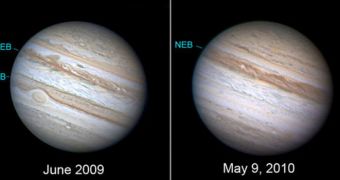According to new images collected by astronomers, it would appear that one of the most prominent clouds on Jupiter has disappeared, almost over night. Images of the gas giant, taken on May 9, reveal a smooth and common area right where the Southern Equatorial Belt should have been. Because the feature is now missing, the famous Great Red Spot on Jupiter is highly-visible, by contrast with its surrounding areas. As astronomers know, the impressive storm was usually located on the edge of the cloud feature that has now disappeared, Space reports.
Four days ago, when Australian astronomer Anthony Wesley looked over his photos of Jupiter, he was amazed to learn that the cloud stripe had disappeared. The Great Red Spot really stood out, mainly because it's incredibly large in itself. It can easily fit two Earths in its diameter, and researchers estimate that the storm has been going on for at least a few centuries. There is no telling when it ends, however, but the disappearance of the Southern Equatorial Belt is proof that such formations can indeed cease to exist. Another result of Jupiter's “transformation” is the fact that the Northern Equatorial Belt now also stands out from the background.
“Jupiter with only one belt is almost like seeing Saturn when its rings are edge-on and invisible for a time – it just doesn't look right,” wrote on his blog Bob King, who is a skywatcher. Truth be told, all amateur astronomers begin by looking at our solar system's gas giants, and also at the smaller, inner planets. Seeing such remarkable changes on celestial bodies that have looked the same for centuries is indeed an event that takes some getting used to.
The disappearance of the cloud feature shouldn't have come as a surprise to astronomers, however. Since 2008, measurements have shown that most spot-like storm features, including the GRS, were shrinking. Experts also identified lower levels of activity in the Southern Equatorial Belt, which also appeared to be diminishing in size. This is not the first instance in which the gas giant shows some anomalous weather patterns. Given the fact that we've only been studying the planet in such close detail for less than a century, it stands to reason that we still don't know how to make sense of a lot of phenomena taking place on the surface.

 14 DAY TRIAL //
14 DAY TRIAL //